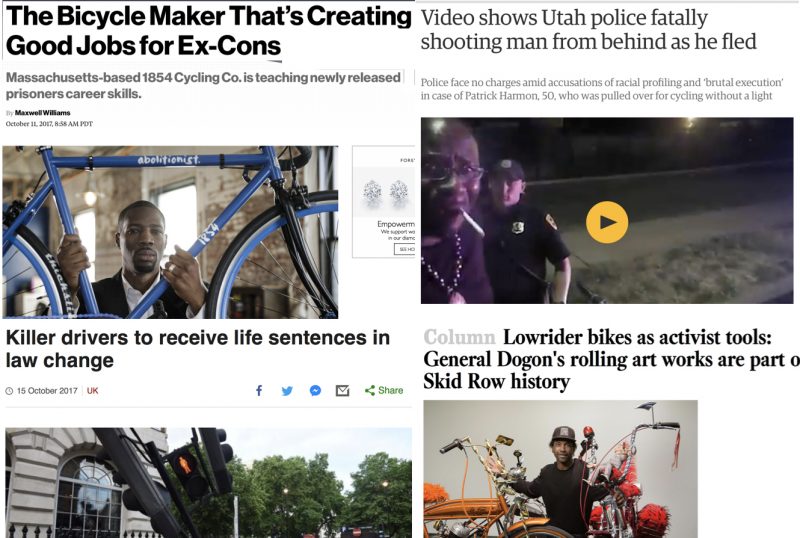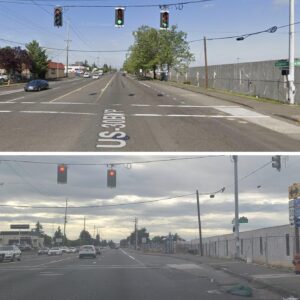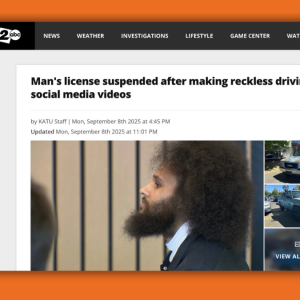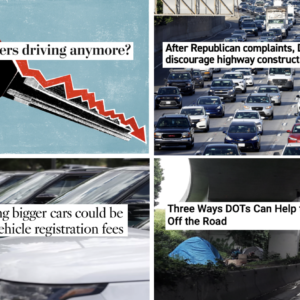
Homeless activism with bikes: I can’t decide what’s more awesome, General Dogon’s life story of criminal-turned-activist, or the fact that he uses tricked out low-rider bikes to help gain attention for his causes.
Inanimate victim-blaming: When drivers failed to control their vehicles and drove up onto cement barriers protecting new bikeways in Queens, critics of the bikeways said it was the barrier’s fault.
Biking while black: Police in Utah shot (three times, in the back) and killed a man who was initially stopped for biking without a rear light.
Bikes rule, cars drool: BikeBiz UK says the startling rise of dockless bike share systems will do more to transform cities than driverless cars.
Bikes rule, cars drool, part two: Oh look, turns out that use of Uber and Lyft have only led to more vehicle miles traveled and more car trips.
‘Hot Pizza’ rider has no shame: A bike rider who slammed into a woman walking on a multi-use path in Spokane has refused to take responsibility for his actions, despite having broken the woman’s arm. Now she’s considering a civil lawsuit.
Advertisement
Unfair trial: This story underscores a rampant problem in America: unfair trials where the jury is biased against bicycle riders and a legal system that protects motor vehicle operators.
Truck sideguard legislation: A California congressman supports legislation that would require sideguards (aka underride guards) on large trucks.
SF bike share kerfluffle: Very intersting situation in San Fran where a new bike share system wants into the market; but the existing, corporate-backed system is reluctant to have any competition. Strong parallels to Portland as Biketown will likely face similar threats from other systems sooner or later.
1854 Cycling Co: This new bike company was inspired by abolitionists that sparked the Civil War and their mission is to put former inmates to work making and selling bicycles. So great I want to buy everything on their website!
DOT engineers and ethics: Here’s the inconvenient truth about transportation engineers at many DOTs: Their decisions to protect the needs of motor vehicle operators above all others is unethical.
We should subsidize e-bikes: Think of all the government subsidies for electric cars — which encourage the most harmful transportation behavior (driving). Now ask why we don’t subsidize e-bikes like they do in Sweden.
Tough on dangerous drivers: In what’s being hailed as a “major victory” for safety advocates, a change in UK law will mean people whose careless driving leads to a death could face life in prison.
How to reduce auto use: Portland is having a hard time actively discouraging auto use. Thankfully here’s a nice roadmap from London that uses a “carrot and stick” approach to lowering auto use and encouraging more biking, walking, and transit.
Passive language is bad: Read this tweet about passive language use perpetuates the status quo and think about how we talk about traffic collisions (this is one reason we take word-choice so seriously here on BP):
Let's change the conversation pic.twitter.com/25tJwBrhfr
— Theatrical Intimacy (@Theatrical_Inti) October 15, 2017
Thanks for all the suggestions this week.
— Jonathan Maus: (503) 706-8804, @jonathan_maus on Twitter and jonathan@bikeportland.org
Never miss a story. Sign-up for the daily BP Headlines email.
BikePortland needs your support.






Thanks for reading.
BikePortland has served this community with independent community journalism since 2005. We rely on subscriptions from readers like you to survive. Your financial support is vital in keeping this valuable resource alive and well.
Please subscribe today to strengthen and expand our work.
I took a lyft from downtown Portland Sunday morning and took 2 drivers find room for my bike.. I would have rode but still healing from injury aka long bike riding weekend.
Very good article listed in today’s roundup, about questions of crime associated with people driving motor vehicles and colliding with vulnerable road users, and the laws on the books available to address consequences of such collisions:
https://nextcity.org/features/view/how-much-is-a-cyclists-life-worth-anyway
The main featured collision at the top of the article is extraordinary. That the woman rider even survived the collision, and then being run over, again after lying on the ground, is amazing. Another one of the type of collision in which, details about investigation of the collision aren’t mentioned in the article. No mention of whether the person driving was DUI, or somehow distracted.
As the article proceeds, there’s some good stuff in it about the quandary police and the courts find themselves in with regards to laws on the books, trying to arrive at a just response to the severity of some collisions between people driving motor vehicles and people riding bikes, with the latter almost inevitably bound to bear the greater injury, or death.
No link for “Biking While Black”? Maybe it’s just me though.
It’s there now. Sorry about that (and other link problems. I really need a proofreader!)
“Self-Driving Cars” is also without a link.
oh I meant to take that story out of the post. sorry. here’s the link if you’d like to check it out.
yes it really shows that gov’t needs to tightly regulate automakers to make sure these features are safe for ALL users.
yeah, that closing line… sheesh…
So glad to see the Curbed article on ride hailing in cities resulting in increased VMT. I really hope this issue will get a lot of attention before we all decide to turn our cities over to autonomous vehicles (with the crazy notion that they will somehow reduce motorized traffic).
The e-bike subsidy is intriguing.
My first reaction was, “Why not? Electric cars get a huge tax credit.” But the arguments I find compelling to support each is different. For example, electric cars need special infrastructure and the subsidy can help with the chicken and egg problem.
However, if e-bikes reduce congestion by getting cars off the road, there is clearly a societal benefit potentially worth subsidizing.
I often question how many people don’t bike because of effort rather than other factors but I have noticed a growing number of older e-bike riders — i.e. exactly the sort of people that e-bikes make sense for and the type of people that would be good to help.
Subsidy for e-bikes also makes fiscal sense: Subsidies for an electric car cost governments and utilities what? $5-$10k per car?
Now let’s subsidize an e-bike at say at most, $1k per bike? That’s potentially a $9k savings for government and $1k makes a HUGE impact on purchasing power of a new e-bike. At $1k subsidy, that’s potentially a $500 e-bike purchase out of pocket.
Completely makes sense.
BTW, Don’t have to wait for Sweden, its already happening in Austin TX!
http://austinenergy.com/wps/portal/ae/green-power/plug-in-austin/two-wheel-electric-riders/!ut/p/a1/jdBNb4JAEAbg38KBI-y4xIq9bbcEqVpORboXg3SETZAly7ab9NeL8dIaP5jbJM-bmbxEkJyItviRVWGkaovmtIunLdCQLjjQJJ7REFjMX5bT7H0yTyYD-PwL0ih9hSRLM5YuOcQ8GJm_MQwe5d9GHKB6zdcVEV1hak-2e0VyY5Vna8TGwwZLo2XpafmFuj951u6CcPAa96hR-996KKI2puufXXDBWutXSlUN-qU6uHAtUqvekPy_JBsi7n3LInoJrtR5Brf76g4f-e8KN6GZJ5I5zhFK8Ytm/dl5/d5/L2dBISEvZ0FBIS9nQSEh/
The same argument could be made for bicycles with the additional benefit of significantly improving health outcomes. A poorly thought out e-bike subsidy could even undermine cycling by making e-bikes cheap enough that people buy them instead of regular bikes.
If we’re going to invest in a giant bike subsidy that has the potential to be a boondoggle, I’d much rather it went into making bike sharing as cheap and widely deployed as possible. Having bikes everywhere that you don’t need to maintain or worry about securing has to be an incentive.
“Purchase Incentives More Cost-Effective for E-Bikes Than EVs”
https://www.navigantresearch.com/blog/purchase-incentives-more-cost-effective-for-e-bikes-than-evs
Is this the same Kyle that didn’t know Strava is used as a transportation planning tool??
Not sure where you got that from as this has been widely known for years. I do wonder exactly how useful it really is as the data hardly represents typical riding habits.
Give SAM a chance and be more respectful. He has proven he has a lot to contribute.
“Listen More Than You Speak”
“We have two ears and one mouth, so we should listen more than we say.”
https://lifehacker.com/listen-more-than-you-speak-1818850037
“People Who Talk the Most Have the Least to Say”
https://www.elitedaily.com/life/culture/quiet-ones-more-intelligent/1112725
Be more respectful yourself — your answer boils down to STFU. If you’re going to say something, contribute your own thoughts point to pithy stuff elsewhere on the internet.
He said let’s subsidize e-bikes, I wondered why a bike should need an electric motor to get subsidized. It’s a legit question, and one I have yet to see a good answer to.
Hmm…who is being respectful, now? (hint: see below)
Do you ever bother to write your own posts? Do you get compensated to boost e-bikes through social media? You realize FCC rules require you to disclose that if you do?
What makes e-bikes so much better than regular bikes that they are worthy of subsidies and regular ones aren’t? They’re more difficult and more costly to maintain and there’s hardly any exercise benefit. It’s a low powered motorcycle — the whole draw for most people is that you get to ride with low effort.
If you’re subsidizing e-bikes, it makes more sense to do this via bike share as far more people can take advantage and it addresses maintenance. BTW, the Moscow bike share has e-bikes — and it doesn’t cost extra to use them.
PDX’s bike share area is so tiny that electric power for such short distances is like using a chain saw to cut butter. Though I suspect people would appreciate the assistance climbing Interstate.
Come to think about it, use of the e-bikes was extremely low while I was out there despite ideal weather. I saw more people on electric unicycles. Those are uncommon, but practical as they’re highly maneuverable and you can pick them up like a briefcase when you enter public transit or a building. I’d totally pick up one of those if they were subsidized.
The e-bike subsidy is truly a middle to upper middle class break. They still will be expensive for poor people and difficult to secure for those who live in apartments.
Oregon already subsidizes bicycles at $15 per bike upon purchase. Oh, wait…
The 15$ bike tax on the bike I’m looking at is effectively a 0.005% tax. I don’t think it’s going to break the bank.
Imagine what Oregon could do for transportation if I (and everyone else) had paid 0.005% tax on all the cars we’ve bought there.
Thanks SAM! and lots of case studies that support your point as well.
“ELECTROMOBILITY FOR ALL: FINANCIAL INCENTIVES FOR E-BIKES HELP TO REALISE ENORMOUS EXTRA CYCLING POTENTIAL ”
https://ecf.com/civicrm/mailing/view?reset=1&id=600
Even car guys think incentives are a great idea.
http://www.greencarreports.com/news/1109711_why-electric-bikes-may-deserve-purchase-incentives-too
And a quote from Pedego CEO: “Don DiCostanzo · CEO at Pedego Electric Bikes
Rebates for electric cars could go a lot further if they applied the same money to electric bicycles!”
http://www.vancitybuzz.com/2015/07/electric-bikes-vancouver/
“Subsidy for e-bikes also makes fiscal sense: Subsidies for an electric car cost governments and utilities what? $5-$10k per car?
Now let’s subsidize an e-bike at say at most, $1k per bike? That’s potentially a $9k savings for government and $1k makes a HUGE impact on purchasing power of a new e-bike. At $1k subsidy, that’s potentially a $500 e-bike purchase out of pocket.
Completely makes sense. …” sam jonas
I think it would be fine in some situations to subsidize ebikes and maybe even bikes with rebates as is done with some electric four wheel vehicles. There’s a huge difference though, generally, in terms of the range of how bikes, ebikes and four wheel electric vehicles are used, and in the cost.
The comparatively much higher vehicle cost of 40-70,000, and the unconventional power source of electric vehicles, probably is the biggest most widely recognized reason that big rebates for electric cars like Tesla, Volt, Leaf, get the big rebate. Lots of interest in getting people to try out those expensive, unconventional motor vehicles. …a 3000-5000 dollar ebike, not so much.
How many people that feel they need the comfort, protection and convenience a car can offer, are going to opt for an ebike instead? Some people do it, but they tend to be hard core devotees, or too poor to buy an electric car instead of a gas fueled car. So they buy the gas fueled car. The rebate for electric cars can help swing their decision to the electric car instead of the gas fueled car.
Thanks wsbob, your response is exactly how everyone should respond. With a different point of view and with respectful tone that encourages dialog.
I really do see your point, and I agree there are plenty of doubts not to incentize e-bikes. Thinking optimistically instead of with criticism.
Lot’s of written precedence that also hints, even with faults, incentives for e-bikes make sense. Here are some other sources that back up my opinion. Enjoy the insightful read.
http://www.vancitybuzz.com/2015/07/electric-bikes-vancouver/
http://pedegoelectricbikes.ca/support-tax-rebates-for-electric-bikes-now/
Here is a story about a person in BC who purchased an EV car and an e-bike. I’m sure your experience may vary.
http://www.vancouversun.com/technology/cayo+bikes+makes+sense/11758163/story.html
sam…thanks for the links. I might take a look at them tomorrow, too late tonight. Though I don’t have one, and really don’t have much experience riding them, I think e-bikes are great. I’ve ridden with people that have them. Amazing difference in accessibility to biking.
Couple days ago, rode up alongside a guy with a bent, Nice Adventure brand, made in Cornwall. It was because of e-assist that he could reasonably do the Fairmount loop. Someday, I think I might like to have one for going back and forth to the grocery store late at night when I often shop because it’s less busy, but when it’s cold and dark. I think lots of people in my neighborhood, likely could be doing the shopping trips with e-bikes and e-bents with a trailer. That could possibly help a whole lot to reduce some of the problem with motor vehicle traffic in the neighborhood, and over at the huge multi-service mall.
Philosophies about rebates as incentives may change, but right now, rebates are mostly about the money, I think. Selling more cars because they’re such a big ticket item, sales of which are vital to the economy.
We’re doing our part to make infrastructure better, expand the network, and encourage cycling through tips, groups, events, and wonderful blogs like this. The federal government can do their part too….a subsidy for e-bikes is a great start if that’s what it takes to get people out of their car. Oh yeah, and while I’m at it, repeal the Oregon bike tax.
Interresting! Take a vacation in Texas during the winter, buy an E-bike, get the rebate and bring it back. Unfortunately it would be cheaper to buy it here and forgo the trip to Texas.
This is the ebike I want: https://www.trekbikes.com/us/en_US/bikes/electric-bikes/crossrip/crossrip/p/1373000-2018/?colorCode=black
Love if I got a $500 subsidy.
$500? How about $1000 for an ebike?
http://www.calbike.org/bike_purchase_incentives
“The program will provide incentives in the form of vouchers for half of the cost of bikes that are commonly used for transportation, up to a maximum value of $500, or $1000 for electric bicycles.”
Find someone on an ebike who is not in better shape than before they got it.
I tow a 100 pound load almost every day and lust after an ebike. I bet you a nickel I would be in worse shape after 3 months though.
I want an ebike so my soon to be 20 mile rt doesn’t consume all my energy.
great news for the UK
Finally, some data that sheds light on what we should have guessed about Uber/Lyft menace: induced demand. Of course, these services are great for people that may be in an occasional bind for transport, and to reduce drunk driving, but on the whole, they are putting more vehicles on the road, travelling more miles, than without these ride-hailing services. We should not be surprised about why many of the Uber trips are getting made (convenience, laziness), and we should expect their unnecessary use to continue to grow.
I’m curious why we always think that releasing induced/latent demand is bad. The number one alternative was “no trip at all.” So that means people are skipping job interviews across town, coffeee with a friend, a trip to see mom, or a happy hour with co-workers because there was no good transit option. That is not necessarily a better result. If transit/cycling advocates are just going to say that VMT is categorically bad, that just doesn’t have enough nuance to describe the reality of the situation.
Obviously it is bad if Lyft/Uber is crowding out transit, biking or walking trips that is not a great thing. But we should also figure out why transit is really not working for people. Transit is really just unacceptably slow and invonvenient for a lot of these trips, and we have to figure out why SOV driving is so much better (and to be clear a lot of what we should do might involve slowing down cars so the difficulty of car travel is closer to in line with its social costs).
Point-to-point on demand travel simply is higher level of service than the current transit model. It’s why I am confident that robot taxis are going to put TriMet out of business if the price is even vaguely competitive.
This.
One thing I’ve never understood is why so many transportation activists seem to take the position that people shouldn’t be going places and when they do, they should move so slowly they can only cover short distances — i.e. they shouldn’t be using transportation at all. Reminds me of health care activists who protest against health coverage.
The reality is that SOV travel is faster, more comfortable, more reliable, and more convenient for most people even at peak times. At non peak times when movement is easy, there is no comparison.
Transit here is hopeless. Even in the best circumstances, it’s too slow and infrequent to be practical except along certain routes. The reliability is a joke — it gets hosed by heat, cold, rain, snow, protests, you name it.
Most people don’t like being out in the elements which should hardly be a surprise since most animals don’t either. This is why the waterfront, Willamette Greenway, Esplanade, and other totally separated and heavily used areas on warm sunny days are desolate when the weather turns.
Part of the reason rideshare works is that it circumvents regulatory requirements, making it much cheaper. The taxi drivers obviously hate them because they steal their business. In SF, these services have become a nightmare to some, because the drivers tend to stop wherever they want to pick up and drop off passengers. Stand in front of the Mosconi Center during a convention, and event though there is a dedicated area designed to flow taxis and rideshare through, the taxi drivers don’t dare get caught not using it, but you’ll find almost all the Lyft/Uber drivers stopping in the bike lanes on the other side of the building.
Yes, and much un-professional driving. In Portland, we find the Uber driver pulling over into the bike lane to deal with passengers, typically after a few 100 yards of driving slowly, pulling over and pulling back without looking for cyclists, staring at their phone, etc. They drive with no respect for any other road user when it’s time to find their fare and engage in pickup/dropoff. It would be nice if they safely pulled over at the next corner or driveway and got out of the way.
I agree that rideshare companies aren’t always the best corporate citizens but if you really have to have your head in the sand to think that regulations that govern taxis are making that industry work at all. The taxi dispatch system is completely unreliable, very recently taxi drivers would try to negotiate higher off-meter rates or claim the credit card machines didn’t work on a pretty regular basis, the recourse for resolving issues with a bad ride is basically nonexistent (whereas Uber and Lyft are pretty responsive to their customers at least). So I really think the reason that Uber and Lyft have been able to get away with breaking these rules is people don’t really think they work for anyone except the taxi cartel.
There is much more recourse against a taxi driver and company than with rideshare companies and drivers. It’s very easy for a taxi driver to lose their medallion, easy to identify a specific cab involved in any transgressions, and persistent video and financial surveillance. The system is far from perfect, but I can tell you the actions my wife experienced by an Uber driver would not have been attempted in front of a taxi’s video camera, and is our prime reason (in addition to what I mentioned) that my money will not go to their companies. And yes, I have experience dealing with both taxi and rideshare companies, aside from just riding in their cars.
Less demand for parking but more demand for traveling = more pressure to convert parking to streets where cars can move, or to widen streets. A lot of people seem to think that Uber/Lyft and then AV will reduce the amount of space dedicated to cars because of less parking demand, but this might be wishful thinking.
The right application of AV coupled with public/mass transit can indeed reduce parking (especially on large campuses and at sporting events): http://easymile.com.
Well, our (USA) public policies make it too convenient and too inexpensive for any driver whether driving themselves or as Uber/Lyft drivers. Costs have to be raised and conveniences and social supports, like free parking, withdrawn to help vehicle miles drop.
Don’t completely discount the possibility that when the robot drivers materialize, we’ll have a whole new paradigm, with a different set of problems, and some of those that seem currently intractable may just disappear. For example, we don’t worry so much about disposing of huge volumes of horse poo deposited on our streets every day.
This guy in Spokane…what a jerk! I guess I’d rather have him on a bike than in a car, but he is the very definition of a thoughtless user of transportation infrastructure. (than which there is no worse condemnation here on Bike Portland 😉
He should be sentenced to taking a LAB Effective Cycling course so he can learn to be a real cyclist, use the roads properly, and not do his speed training on multi-use paths.
As a cyclist, I officially disown the ” hot pizza” guy. We tend to assume that cyclist are good people, but that does not mean that from time to time a bad apple doesn’t takes up cycling instead of racing around in motorcars. From his behavior in this instance and his injury history and think he is a bad apple, but I am still glad he is cycling instead of driving where he could do a lot more damage.
Eh – I don’t agree with what he did and how is he handling it, but I don’t entirely disagree with his frustration either.
I do.
Anyone who thinks peds have an obligation to watch out for cyclists coming from behind and get out of the way has no right to whine about drivers thinking cyclists are in their way.
If you don’t like peds, dog walkers, kids, slow riders, etc. ride on the roads. Plenty of cyclists do.
From the article: “Haller said he calls it a good day when he makes it home without an accident. ”
That level of irresponsibility is epic. I haven’t even heard of a cyclist that bad before.
The path has a 15 mph speed limit! Case closed, it’s a MUP, not a bike route. If you’re race training, a MUP with pedestrians, pets, and strollers is not where you should be.
Do you think he was going faster than 25mph? That extra 10mph over the posted speed doesn’t matter with cars on greenways, right?
Bad apples, to use the name you chose for them, walk, drive motor vehicles, ride bikes and skateboards. These people are the culprits that make use of the roads and other public way, tough for everyone.
Justin Haller, the 45 yr old guy, biking, delivering pizzas, charging down an MUP where people were walking, expecting people to jump out of his way so he doesn’t have to slow down, because he hates slowing down. Same self absorbed, dangerous behavior of people that walk out in front of traffic to see the way is clear, or that won’t signal turns when riding or driving.
Haller must be some kind of lucky guy though. Colliding with anyone while riding a bike is not a good thing, but I can’t help realize how lucky he was not to have run into a guy maybe around 6’4, 300 lbs, and a body builder.
I don’t know how lucky he is — he has broken 25 bones. At the very least, his handling and falling skills are in question. I’m guessing this is not the first injury he’s caused to someone else.
I’m hoping the article prompts stable cyclists keep an eye out and help slow him down. As a practical matter, there are very few tools available if he’s not cooperative.
Unapologetically mowing down old ladies is as low as it gets. I would have normally dismissed this article as made up garbage as it is so ridiculous, but it was easy to verify through multiple sources. Sadly, this story will provoke haters and all cyclists will suffer.
I was attempting to hint at a joke without being to obvious about what I had in mind. Think about it…would this guy do what he did, if he saw some hulk up ahead of him? Someone that might not take lightly to being expected to hop out of the way? Instead, he picks on old ladies, about whom he probably has figured aren’t going to go after him.
That story doesn’t make much sense. The left side of the trail was “wide open” and he just plowed into the people in front of him? Was he drunk?
Driving on the bike lane – problem.
Driving on a concrete barrier – one less bike lane driver.
A few barriers placed along the bike lanes and moved every few weeks, should cut down on the number of drivers who can’t be bothered with watching where they are going or keeping their vehicles in the lane.
This is a great money saving idea. Instead of the cost of permanent barriers separating major bike lanes from traffic, we just have a few specially designed ( sloping front to high center motorist instead of instant stop) barriers that can be moved around randomly. Those who have studied the behavioral experiments of BF Skinner will recognize that random reinforcement is more effective than continuous reinforcement.
Claymore Bollards…
I think the randomness only works with rewards, not punishments. That’s why random enforcement of traffic laws results in no behavior change, but people will sit at a slot machine for hours on end.
I always thought that slot machines were a punishment.
That would be awesome. Just last night I was nearly struck by two separate cars while i was walking on a sidewalk that is adjacent to a bike lane. Each of the drivers came within an inch of jumping the curb that was over five feet outside of their lane. A few mobile barriers would either correct their behavior or have them saving for a new car and the scratch to pay the insurance.
To understand how well AV use will be controlled by planners and elected officials, just look at how helpless planners and elected officials are in regulating car use or even Uber/Lyft use.
AV associated corporations will demand greater control over and public investment in roads and an impatient uninformed public will, with a straight face, demand more traffic to reduce the time they have to spend driving.
People who fantasize about an AV solution to urban transit problems need to understand that “the market” is not working in their favor.
Not to mention the tens of millions of taxpayer dollars being invested in wireless “vehicle-to-vehicle” research that will, ahem, improve safety and traffic.
Regarding passive language, passive language is appropriate if it provides a more accurate account. To take the example in the linked story, the number of girls or women who got pregnant is not the same as the number of boys or men who got girls or women pregnant (for fairly obvious reasons). And the latter number may be pretty difficult to divine (again for fairly obvious reasons to anyone who thinks about it). While I agree about the political point of distancing men from problems that they cause, I don’t think encouraging imprecise language is the right remedy.
thanks chris m. I think in this context the political point is much more important and more powerful than the stats and facts. I flagged that tweet because I think in general we need to remember that the passive voice often protects the more powerful party and we can’t unseat that power until we begin to name it directly.
It’s an important perspective for sure and we do have to think about how we communicate on these issues.
In addition, focusing only on how many impregnators impregnated teenage girls suggests a lack of agency on behalf of the impregnatees. I think both numbers are important.
About the passive language issue: This is not at all specific to crimes against women. We use similar language for almost every crime: How many cars were stolen; people murdered; houses burgled; how many had their identities stolen; and so on.
I agree that focusing on the number of perpetrators would be more informative than the number of victims, but, as chris m pointed about above, we don’t generally know that number.
It is important to refrain from using the passive construction. We need to talk about women who have falsely accused men of rape. Remember, one in three men will be falsely accused of rape during their lives. That is one in three.
And yet… you use a passive construction.
I’m not sure I agree that focusing on the number of perpetrators is more informative — the number of crimes and victims does a much better job of conveying impact. The number of perpetrators or potential perpetrators is not irrelevant, but it distracts away from the crime itself.
I’m pretty sure I don’t care about the number of garbage trucks on the roads if a reckless driver in one kills someone.
On the contrary… if, for example, a single male had participated in the impregnation of all of Vermont’s pregnant teens, I think that would tell us a lot about the issue.
Yeah, he got busy!
Speaking of perspective: http://www.wedgelive.com/2017/10/minneapolis-politicians-attend-protest.html
So…in SLC. ..cop is fired for arresting white nurse and the DA backs the cops who shoot a black man in the back and kill him. Par for the course in slc.
the article about shooting the black man in that back was pretty sad… until I got to the part where he had an outstanding warrant for aggravated assault… cops were preventing a dangerous man from being on the loose… no jury will convict them for that… when you’re a wanted man you don’t draw attention to yourself like that guy did…
They shot an unarmed man in the back as he ran away. You think that’s reasonable policing? What about, I don’t know, running after him?
It does not sound like reasonable policing. That said, we don’t yet know the full story. That said, it is hard to imagine circumstances that would justify shooting, regardless of what warrants were outstanding.
That nurse followed protocol and the officer ignored repeated requests to engage her supervisor. I think it’s as irrelevant that she is white, as it is that it was in Utah.
I couldn’t disagree with you more.
Do you think the officer arrested her because of her race?
If we’re talking about the same nurse – the one who refused to draw blood for the policeman and was subsequently restrained and arrested – then I can tell you that police officers do not have the right to request blood samples like that. It is a violation of HIPAA. They must wait for the patient to be released and then have their own medical staff administer the testing. At least that’s what my wife told me, and she ran an emergency department at KP for 17 years.
If that’s not the story I’m thinking of, then I apologize for the confusion, but I still haven’t seen evidence presented that race or location are relevant.
You have the right nurse story.
I used to commute on that stretch of Northern Blvd every day when I lived in Queens and worked in LI. That was a a bottle neck of stupid and found that the times I felt safest was when traffic was gridlocked for one reason or another. I can recall 2 or three times getting hit by (and even chased by) motorists there. Some sort of barrier would have been quite nice, though it is not the least bit surprising that people are driving their cars up on it.